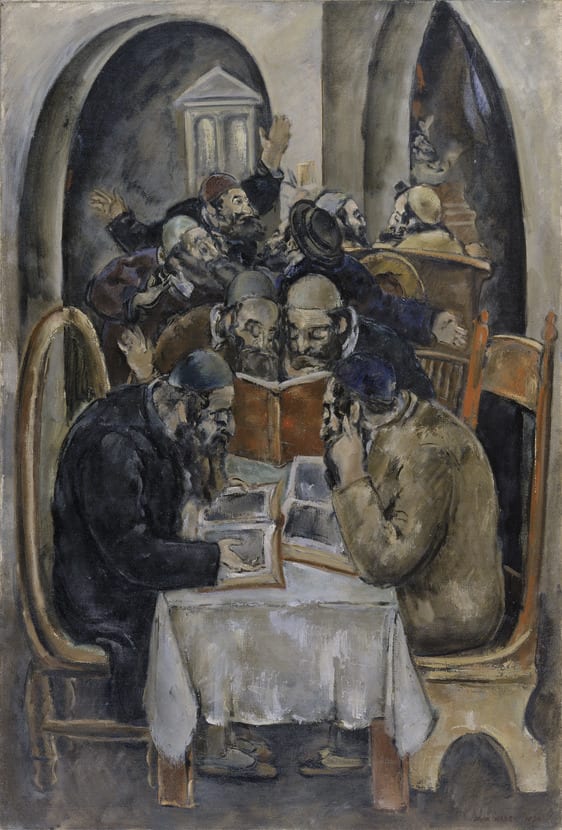
- Artist/Maker:
- Max Weber
- Bio:
- American, b. Russia, 1881-1961
- Title:
- The Talmudists
- Date:
- 1934
- Medium:
- Oil on canvas
- Dimensions:
- 50 1/8 × 34 in. (127.3 × 86.4 cm)
- Credit Line:
- Gift of Mrs. Nathan Miller
- Accession Number:
- JM 51-48
Not On View
The advent of modernism which seemed to eliminate most narrative themes from the artistic repertoire, coincided with an influx of Jews into the visual arts. As a result, the Jewish painter no longer needed to reconcile his religious background with his goals as an artist. Abstract, formal elements-composition, color, and the surface treatment-were all that seemed necessary to create pictures. Nevertheless, after a brief immersion in the new modern syntax, certain Jewish painters did adapt the vocabulary of modern painting to representations of Jewish themes. In France, Marc Chagall created his mythical images of Russian shtetl life through a synthesis with Cubist style, while the English artist Jacob Kramer fused Vorticism into pictures of cogent Jewish spirituality.
Max Weber, one of the vanguard American modernists, was one of these few artists to include religious subjects in his work, and he was considered the first American exponent of Jewish imagery. Weber's early work shows the Fauve influence of his teacher Henri Matisse and the Cubist influence of Braque and Picasso. But there is little evidence of his later inclination toward Jewish subject matter until 1918. As a response to the death of his father in that year and to moral disillusionment with American art and world values during the war, Weber's art turned inward. He pursued the spiritual over the material values he had previously espoused and concentrated on human activity over formal experimentation Weber painted a series of heads of rabbis and scenes of Jewish ritual such as his 1919 Sabbath as the coalescence of his religious background with his artistic goals.
The thirties are considered by Milton Brown to be the first period in which Weber's art represents a mature integration of personal expression and style. The Talmudists, rendered in the dark earth-tone palette of Weber's Depression period works, has a nervous line and Mannerist composition that betrays Weber's admiration of El Greco. Weber was capable here of making a lyrical transformation of Christian aesthetics into Jewish spirituality. He appropriated the gestures of El Greco's ecstatic Christian figures and saints for the excited gesticulation of the mystical Hasidic sect. His portrayal of the scholars interacting with their sacred texts and with each other demonstrates Weber's passionate interest in the meaning of spirituality, communication, and gesture.
Max Weber, one of the vanguard American modernists, was one of these few artists to include religious subjects in his work, and he was considered the first American exponent of Jewish imagery. Weber's early work shows the Fauve influence of his teacher Henri Matisse and the Cubist influence of Braque and Picasso. But there is little evidence of his later inclination toward Jewish subject matter until 1918. As a response to the death of his father in that year and to moral disillusionment with American art and world values during the war, Weber's art turned inward. He pursued the spiritual over the material values he had previously espoused and concentrated on human activity over formal experimentation Weber painted a series of heads of rabbis and scenes of Jewish ritual such as his 1919 Sabbath as the coalescence of his religious background with his artistic goals.
The thirties are considered by Milton Brown to be the first period in which Weber's art represents a mature integration of personal expression and style. The Talmudists, rendered in the dark earth-tone palette of Weber's Depression period works, has a nervous line and Mannerist composition that betrays Weber's admiration of El Greco. Weber was capable here of making a lyrical transformation of Christian aesthetics into Jewish spirituality. He appropriated the gestures of El Greco's ecstatic Christian figures and saints for the excited gesticulation of the mystical Hasidic sect. His portrayal of the scholars interacting with their sacred texts and with each other demonstrates Weber's passionate interest in the meaning of spirituality, communication, and gesture.
Information may change as a result of ongoing research.